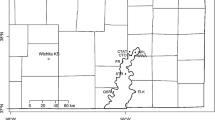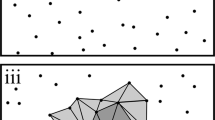Abstract
Canopy gap area/age distributions and growth mechanisms were examined in a virgin subalpine forest in the White Mountains, New Hampshire, USA. The gap area distribution was negative exponential in form. Whithin gap tree ages varied widely in response to stepwise gap expansion caused by windthrow of peripheral trees or death of standing mature Picea rubens at gap edges. As a consequence, the density of small gaps may have been underestimated and the density of large gaps overestimated. The estimates of canopy turnover time, 303 yr, and of patch birth rate on an area basis, 3.3×10-3 ha new patches/ha land area/yr, were not affected by the gap expansion phenomenon. However, any estimate of patch birth rate as numbers of new patches formed per year would have been too low. Because of increasingly widespread Picea death, the patch area/age distribution of this forest may not currently be in steady-state.
Similar content being viewed by others
References
Alexander, R. R., 1964. Minimizing windfall around clear cuttings in spruce-fir forests. For. Sci. 10: 130–142.
Bormann, F. H. & Likens, G. E., 1979. Pattern and process in a forested ecosystem. Springer-Verlag, New York.
Brunig, E. F., 1964. A study of damage attributed to lightning in two areas of Shorea albida forest in Sarawak. Empire For. Rev. 43: 134–144.
Forter, J.R. & Reiners, W. A., 1983. Vegetation patterns in a virgin subalpine forest at Crawford Notch, White Mountains, New Hampshire. Bull. Torrey Bot. Club 110: 141–153.
Hartsborn, G. S., 1980. Neotropical forest dyamics. Biotropica 12 (suppl.): 23–30.
Johnson, A. H. & Siccama, T. G., 1983. Acid deposition and forest decline. Environ. Sci. Technol. 17: 294A-305A.
Levin, S. A. & Paine, R. T., 1974. Disturbance, patch formation, and community structure. Proc. Nat. Acad. Sci. (USA) 71: 2744–2747.
Naka, K., 1982. Community dynamics of evergreen broadleaf forests in southwestern Japan. I. Wind damaged trees and canopy gaps in an evergreen oak forest. Bot. Mag. (Tokyo) 95: 385–399.
Paine, R. T. & Levin, S. A., 1981. Intertidal landscapes: disturbance and the dynamics of pattern. Ecol. Monogr. 51: 145–178.
Poore, M. E. D., 1986. Studies in Malaysian rain forest. I. The forest on the Triassic sediments in Jengka Forest Reserve. J. Ecol. 56: 143–196.
Putz, F. E. & Milton, K., 1982. Tree mortality rates on Barro Colorado Island. In: E. G., LeighJr, A. S., Rand & D. M., Windsor (eds), The ecology of a neotropical forest: seasonal rhythms and longer-term changes, pp. 95–100. Smithsonian Institution Press, Washington, D.C.
Runkle, J. R., 1979. Gap phase dynamics in climax mesic forest. Ph.D. thesis, Cornell University, Ithaca, New York.
Runkle, J. R., 1982. Patterns of disturbance in some old-growth mesic forests of North America. Ecology 63: 1533–1556.
Runkle, J. R., 1984. Development of woody vegetation in treefall gaps in a beech-sugar maple forest. Holarctic Ecol. 7: 157–164.
Scott, J. T., Siccama, T. G., Johnson, A. H. & Breisch, A. R., 1984. Decline of red spruce in the Adirondacks, New York. Bull. Torrey Bot. Club 111: 438–444.
Siccama, T. G., Bliss, M. & Vogelmann, H. W., 1982. Decline of red spruce in the Green Mountains of Vermont. Bull. Torrey Bot. Club 109: 162–168.
Spaulding, P., 1937. Estimating the length of time that trees have been dead in northern New England. J. For. 35: 393–395.
White, P. S., MacKenzie, M. D. & Busing, R. T., 1985. Natural disturbance and gap phase dynamics in southern Appalachian spruce-fir forests, USA. Can. J. For. Res. 15: 233–240.
Author information
Authors and Affiliations
Additional information
Nomenclature follows Fernald (1950), Gray's Manual of Botany.
We thank the personnel of the White Mountain National Forest and Crawford Notch State Park for permission to sample, Chris Lynnes for field assistance, and Peter White for a manuscript review. This study was supported by a Sigma Xi Grant-in-Aid-of-Research, the Dartmouth College Cramer Fund, and NSF Grant DEB-7407346.
Rights and permissions
About this article
Cite this article
Foster, J.R., Reiners, W.A. Size distribution and expansion of canopy gaps in a northern Appalachian spruce-fir forest. Vegetatio 68, 109–114 (1986). https://doi.org/10.1007/BF00045062
Accepted:
Issue Date:
DOI: https://doi.org/10.1007/BF00045062




